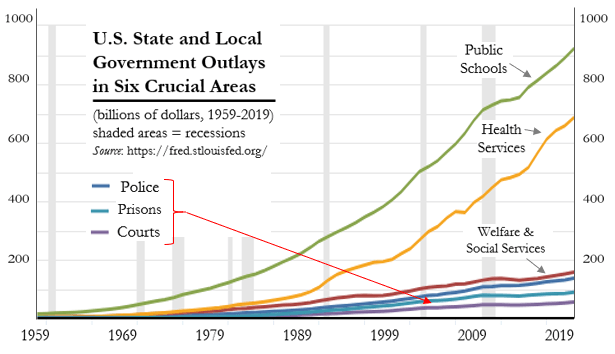Funding American Law Enforcement

Police, courts, and prisons comprise the bulk of public law enforcement services in America; most of them are provided and funded at state and municipal levels of government. Do these services deserve less support, more support, or different types of support?
Fans of free markets debate how much government should be involved with law enforcement, some saying it should be provided solely by government, others that it should be a mix of public and private services, and still others that it be provided only privately. I endorse legitimate public law (and legitimate law enforcement by public officials) while recognizing that the right of self-defense is only partially delegated to a state, never surrendered, which leaves wide scope for private security and arbitration services.
Recent calls to “defund” various parts of America’s public law enforcement system presume that less (or no) funding will fix supposedly material rates of racism, bias, and brutality. Critics of the current system also imply that social conditions will improve with relatively more public spending on other services. Unfortunately, today’s debate rarely provides sufficient perspective by consulting facts or trends. Below I provide some crucial facts and context back to the late 1950s.
The nearby exhibit presents the evidence on funding for six crucial areas over the past six decades. Three of them are closely related, of course: police, prisons, and courts. Spending in these areas, pertaining to law and order, has significantly trailed spending on public schools, health services, and welfare/social services. State and local budgets are limited, so outlays in one area come at the expense of others. Relative spending reflects differing commitments of voters and politicians. The priority in recent decades has not been on law and order. Policing has been effectively defunded.

Of course, public spending alone is not a sufficient measure of the quality of any public service, whether policing, schooling, or health care. Higher quality can accompany lesser funding and lower quality can accompany greater funding. There is far more evidence that the quality of American policing has improved over the years, relative to its lesser funding, than there is evidence that the quality of public schools or public health care has improved relative to their greater funding. Although evidence is abundant that the quality of public schools has declined materially relative to funding, almost no one wants to “defund public schools.” The failure of public schools is met, instead, with calls for even more public funding – without real reforms.
There is a close but rarely acknowledged link between schooling and policing. To the extent public schools fail – generating illiteracy, innumeracy, and truancy – they fail students and resign them (and their progeny) to cycles of poverty and criminality. The failed students of inferior schools are more likely to engage in lawbreaking, and to face law enforcement officials who are certainly not responsible for the poor quality of public schools. Public ownership and control of the means of instruction has proved as deleterious as public ownership and control of the means of production.
Social conditions can worsen further to the extent public schools teach students that “all” police are racist abusers of the innocent. This ensures that when untutored, crime-prone, angry, and resentful youths come in contact with law enforcement officers they will more likely resent it, resist arrest, fight or flee, and thus endanger themselves (and officers). It is an avoidable tragedy.
It is paradoxical that in nearly all types of public goods and services except policing, government failures elicit demands for still more funding, not less. National defense failed America on 9/11 yet the response was to create and fund a new and expensive Department of Homeland Security. When public schools fail the response is to spend more taxpayer money on them, while resisting reforms and competition (from charter schools and private schools). When the provision of public health services are materially inferior to private provision, as in the case of the VA hospital system, the response is to spend more public money on it, without viable reform. Yet if policing fails, critics demand that less be spent on it – or nothing at all – to “defund the police.” Why?
For many decades – until recent ones – national defense, policing, prisons, and law courts were defined and defended as indispensable functions of a rights-respecting government. They were “public goods,” per economists, in the sense that it was too difficult or costly (unprofitable) for the private sector to provide them. Moreover, these functions involved the use of force, which should be left not to markets (or vigilantism) but to an agency (government) compelled to be just and to abide by the restrictions imposed by a rights-protecting constitution and subsidiary law code.
In recent decades, the scope of “public goods” has expanded far beyond national defense and law enforcement (policing, prisons, law courts). This is observable in public spending priorities and trends over time (see exhibit). The private sector is capable and willing to provide schooling, health care, and welfare services (philanthropy), but these services have been increasingly co-opted by the public sector, with inferior quality due to an absence of profit-loss incentives. Public provision also violates rights, by simultaneously precluding choice and compelling funding. Many Americans have lost the meaning of rights – and many believe it is better morally to have more citizens subject to similar but lower-quality public goods and services than to leave them free to provide and purchase differential, higher-quality private goods and services. It is not a rationally defensible position. The public provision of private goods and services has a terrible track record.
Law and order, hence law enforcement, is a crucial role of a just government. The laws must be just but also justly applied and enforced. If the quantity, quality, or justice of public policing is inferior or deteriorating, that argues not for defunding but more funding. If any legitimate public service (like the rule of law and law enforcement) fails, it should be mended, not ended, reformed, not scorned. Indeed, that has been the general (and positive) trend in American law and law enforcement over the past century. Studies today find only traces of racism and brutality in American policing; no solid evidence exists for such evils being “systemic,” when adjusted for socio-economic factors and differential crime rates. Nor is there systematic evidence that the funding of police has come at the expense of other public services; indeed, policing has been relatively “defunded,” already, since the 1960s, which may be contributing to current problems.










